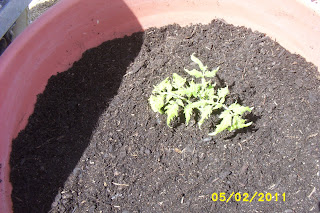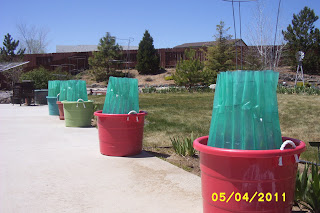The squirrel is back. Almost all of the Grape Hyacinth are gone. I have gone out there three different times in two days and found freshly dug soil and the flowers, stocks and leaves haven't begun to wilt. I will catch him!
In the same bed a quail has dug a little bowl to sit it. They do this all over the yard near plants that have been watered and the soil is cool, but not wet.
Transplanted a bunch of violas from the iris bed here and planted petunias that I had just bought for something else. With enough plants in here the quail won't have a place to dig.
Sat the squirrel trap on top of the Grape Hyacinths. With my luck he will just dig under the trap. Going to fix that.
Put a rag over the flowers and then the trap on top of it. Used a big rock to hold the cloth down too. Now if the weather ever warms up enough for him to come back I hope I catch him. Strawberries and half eaten Grape Hyacinth bulbs are in a tuna can in the trap. Have since bought raw unshelled sunflower seeds to put in there.
This is hard to see. In the background are raspberry bushes. A cat is using that area just in front of the bushes as a bathroom. I bought 2 boxes of moth balls and broke them into pieces. Larry and I spread them over a much of the sandy yard as possible. After the few drops of rain 2 days later the moth balls are gone. That's OK, because it stunk outside. Three days later and the cat has a new place in our yard to go. Went to the store and bought red pepper flakes in bulk. Sprinkled them everywhere the ground is sandy. So far it is working. It doesn't stink outside either. Sat up the cat trap along its trail. Put a fish stick in the trap yesterday. Today the fish stick is gone and the trap is still open. Darn!
Following a dove around the yard. He was eating something. It better be weed seeds.
This bird isn't worried about getting away.
This garden bed is empty right now. I have had birds (dove?) dig up garden seeds. I have screens to protect the seeds and will post pictures later. Finally he flew away. The dove and quail live under the pine trees in my yard.
Things I have learned about gardening that I hope will help you. My main focus is vegetable gardening. Anything that I think is helpful regarding outdoor plants and pests I will post.
Saturday, May 28, 2011
What's happening in the garden lately?
Almost all of our asparagus died 2 years ago. We planted new last year. Here it is growing with the parsley that managed to survive the tilling and digging. The big bunch of asparagus in the front is about 14 years old. Most asparagus lives 10 - 12 years. Parsley and asparagus are great companions.
Twelve days later and look at how much everything has grown. The asparagus in the front is almost 6 feet tall. We do not cut the asparagus fronds. We leave them to feed the roots. Next spring we will cut/break them off at ground level. In years past the fronds have been so dense laying on the ground that they have made a great ground cover and the asparagus has started growing in January.
I took the pink cover off of the end of the broccoli, Brussels sprouts, and cabbage bed so you can see how they are growing above the original cover, but this weather is getting to freezing and below still.
A tiny head of broccoli is forming.
Another tiny head. These plants really are the same color. Don't know what happened. Now is the time to start seeds indoors for the fall crop, but the spring crop isn't very far along yet.
Here is one of the heads of cabbage forming. If the weather ever warms up enough for them to stay uncovered, the cabbage moth will be showing up. I will be covering these with bridal tulle soon. Pictures will be posted.
Another cabbage plant. This should be forming into a head soon.
This bed of potatoes did not get covered a couple of weeks before this picture was taken. Everything was brown, because it froze. As you can see now it is coming back.
Another picture from the same potato bed after the freeze.
Now that all the tomatoes and tomatillas have a Wall of Water around each of them and a tomato cage around the plant too, it has become a pain to protect them from frost. Larry thought of dropping empty buckets (my rain water ones) inside the cages to protect them. So far it has worked good. There are 15 of these. I am all for lazy gardening.
The weather was nice one day about a week ago. Larry mowed the lawn. Randy Robison teaches in his classes to add a thick layer of grass (chemical free) or alfalfa pellets around the tomato plants and inside the Wall of Water. It is to stay there all summer. We decided to give it a try. The plants are still little, so the grass is about 3 to 4 inches deep.
Same thing here. This one is a tomatilla and little taller plant. I don't think we will add more grass. Will keep you posted.
Can you see the rhubarb flower? I can only because I know where to look. It is center front. I know that at least 7 flowers have been cut off at the base of 3 plants already. All these flowers mean that it is time to dig them up and divide them next spring. Let me now if you want rhubarb.
Here is a closeup of a rhubarb flower. There are four flowers at different stages of development right now. This one is the largest.
Twelve days later and look at how much everything has grown. The asparagus in the front is almost 6 feet tall. We do not cut the asparagus fronds. We leave them to feed the roots. Next spring we will cut/break them off at ground level. In years past the fronds have been so dense laying on the ground that they have made a great ground cover and the asparagus has started growing in January.
I took the pink cover off of the end of the broccoli, Brussels sprouts, and cabbage bed so you can see how they are growing above the original cover, but this weather is getting to freezing and below still.
A tiny head of broccoli is forming.
Another tiny head. These plants really are the same color. Don't know what happened. Now is the time to start seeds indoors for the fall crop, but the spring crop isn't very far along yet.
Here is one of the heads of cabbage forming. If the weather ever warms up enough for them to stay uncovered, the cabbage moth will be showing up. I will be covering these with bridal tulle soon. Pictures will be posted.
Another cabbage plant. This should be forming into a head soon.
This bed of potatoes did not get covered a couple of weeks before this picture was taken. Everything was brown, because it froze. As you can see now it is coming back.
Another picture from the same potato bed after the freeze.
Now that all the tomatoes and tomatillas have a Wall of Water around each of them and a tomato cage around the plant too, it has become a pain to protect them from frost. Larry thought of dropping empty buckets (my rain water ones) inside the cages to protect them. So far it has worked good. There are 15 of these. I am all for lazy gardening.
The weather was nice one day about a week ago. Larry mowed the lawn. Randy Robison teaches in his classes to add a thick layer of grass (chemical free) or alfalfa pellets around the tomato plants and inside the Wall of Water. It is to stay there all summer. We decided to give it a try. The plants are still little, so the grass is about 3 to 4 inches deep.
Same thing here. This one is a tomatilla and little taller plant. I don't think we will add more grass. Will keep you posted.
Can you see the rhubarb flower? I can only because I know where to look. It is center front. I know that at least 7 flowers have been cut off at the base of 3 plants already. All these flowers mean that it is time to dig them up and divide them next spring. Let me now if you want rhubarb.
Here is a closeup of a rhubarb flower. There are four flowers at different stages of development right now. This one is the largest.
Bugs on Basil
I am guessing that these are aphids on my basil. This is a first for me. I was being lazy and used an insecticidal soap to spray them. Normally I keep a 2 quart spray bottle ready for all little bugs on plants indoors and outdoors. I put about 1 inch of dish detergent in the bottle and fill the rest with water. Don't use dish soap. Dish soap will not kill the bugs. Is there even such a thing as dish soap anymore?
Labels:
aphids,
bugs,
dish detergent
Treating Roses for Aphids
Add a good layer of Epsom Salt around your roses. I used a 4 pound bag for 5 rose bushes. Epsom Salt contains magnesium which is good for feeding roses also.
Next water it well. You don't have to get all of the Epsom Salt dissolved right away. Just most of it.
Next water it well. You don't have to get all of the Epsom Salt dissolved right away. Just most of it.
After adding Epsom Salt.
After Watering.
Labels:
aphins on roses,
Epsom Salt,
roses
Thursday, May 5, 2011
Planting Tomatoes
Two more tubs and a pot for tomatoes.
First is a thick layer of gravel in the bottom of each tub.
Next is a single layer of Floating Row Cover. I had a large piece that was torn, so I cut it into pieces that would fit in the tub. This will keep the soil from going in the gravel and allow the water to drain below the soil. This should keep them from getting over watered.
Here is one of the tomato plants I started indoors from a seed. On the right is the same plant with the bottom leaves removed for planting. Remove the bottom leaves when planting in containers or in the ground.
The plant will stand up by itself once all the soil in press in around it. Roots will grow all along the buried stem and create a strong root system for the tomato plant. Give the plant with lots of water when finished.
Here are some of the tubs and the pot when finished. The Walls-of-Water are half filled. They have tomato cages in them to hold them open. They are now protected from the wind, but open so they don't die of heat. When it gets cold the tomato cages can be remove and the Walls-of-Water can be closed.
Subscribe to:
Comments (Atom)






































